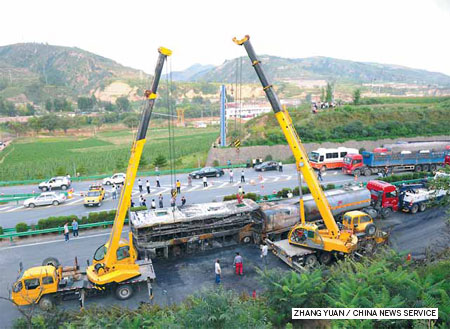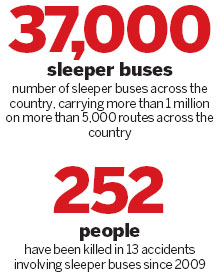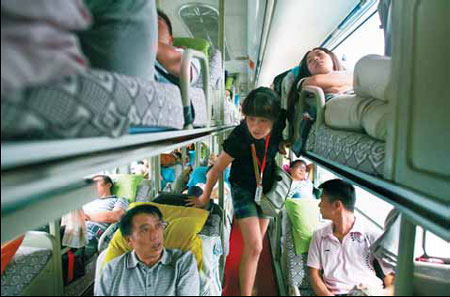Cheap, cheerful, but dangerous
Updated: 2012-08-29 07:27
By Hu Yongqi and Wu Wencong (China Daily)
|
||||||||

|
Top: A sleeper bus crashed into the back of a tanker carrying methanol, a highly combustible liquid, on a highway in Yan'an, Shaanxi province, resulting in 36 fatalities and 3 injuries on Aug 26. Above: A bus company staff member explains the safety rules to passengers at Sanfuwan bus terminal in Xi'an, capital of Shaanxi province on Monday. Ma Jiewen / for China Daily |

Sunday's fatal bus crash in Shaanxi province was the latest in a series of accidents that have claimed lives across China. Despite this, people continue to use the buses for a variety of reasons. Hu Yongqi and Wu Wencong report from Beijing.
At present, around 37,000 sleeper buses carry more than 1 million passengers on more than 5,000 routes across the country. Since January 2009, at least 252 people have been killed in 13 accidents involving sleeper buses.
Given the potential dangers and the history, why do people continue to take the risk?
"You really don't think too much, not even about safety, when you have no alternative," said Cheng Zhonghong, a 26-year-old engineer who regularly traveled on sleeper buses in the Xinjiang Uygur autonomous region from 2004 to 2010.
Cheng recalled his first experience on a double-decker sleeper bus eight years ago, when he traveled from the Ili Kazak autonomous prefecture in the west of Xinjiang to Urumqi, the capital city.
There were three rows of bunk beds on the bus, each connected end to end. There were usually around 30 beds, he said. "The bed was really narrow, about the width of a chair, and the aisles between the bunks were even narrower. One had to turn sideways in order to move forward and it was impossible for two people to pass in the aisles."
Cheng said he was so scared that he barely slept during the 10-hour trip. "I was on the upper bunk and the bus was swaying wildly because about 200 kilometers out of the total 500 km route consisted of the twisting roads that cross the Tianshan Mountains," he said. "But after using the buses a number of times, I got used to it and slept for most of the journey."
Experts said that the convenience of sleeper buses and low ticket prices were the main reasons they remain popular, and that design flaws and driver negligence were the primary causes of accidents.
Market choice
Unlike Xinjiang, other regions in China have efficient railway systems, but people continue to use sleeper buses.
In April, Qin Menglong, a 31-year-old company sales representative, used her new car to travel to her hometown of Linhe district of Bayannur League in the Inner Mongolia autonomous region. She said she didn't miss the smelly, overcrowded buses at all.
Qin said ease of convenience has ensured that sleeper buses are the most popular form of transport for traders and migrant workers moving between Linhe and Beijing.
Every 30 minutes, the buses depart from Beijing and Linhe to the other end of the route. Wholesalers getting off buses from Linhe at around lunchtime throng directly to the markets in Beijing's Dahongmen area and rush to purchase all the commodities on their list before 4:30 pm to ensure they can catch the next bus home. The buses have large amounts of storage space for passengers' carry-on luggage, and traders benefit as their goods are unloaded outside their stores, meaning that they don't have the trouble of carrying loads from the station.
By contrast, rail transport is cheaper, but nowhere near as convenient. Every day, three trains reach Linhe at around 3 am, while three others arrive in Beijing around 3 pm. The timing is unsuitable for the traders and people heading to work in Beijing, said Qin.
Train tickets for the route cost around 150 yuan ($23.50), that's 100 yuan less than the cost of the bus, but the price differential fails to give the rail companies an advantage, because it's often extremely difficult to buy train tickets during peak travel seasons such as Spring Festival or the summer holiday.
Qin's husband Zheng Xing, 34, said he always remained awake when traveling by bus. "I always chatted to the driver to make sure he was fully alert and I reminded him of the potential dangers."
Drivers are key
Sleeper buses went into operation in China during the early 1990s when the country's rail network was underdeveloped and unable to meet the passenger demand, according to Wang Dongming, a researcher at the Institute of Comprehensive Transportation of National Development and Reform Commission in Beijing.
Some routes for sleeper buses entail hundreds of kilometers, with the longest - between Shanghai and the provinces of Sichuan and Guangdong - clocking in at more than 2,000 km.
Wang said sleeper buses have a number of design flaws, meaning that the aisles are overcrowded and the emergency windows are often difficult to break. However, the driver is the key to safety.
Long-distance buses are required to have two drivers, who each take the wheel for four-hour stretches. But while the laws are fine in theory, in reality they are often ignored by bus companies in search of increased profits.
Wang Yicun, 34, from Yuexi county in Anhui province, drove sleeper buses for eight years. Before new regulations were introduced in 2006, local bus companies could double their ticket prices during the Spring Festival rush. During a single month, drivers could earn as much as 20,000 yuan - as much as they could earn in the rest of the year - so they worked as many hours as possible, even when they were exhausted.
In February 2006, Wang drove a sleeper bus to Hangzhou, the capital of Zhejiang province. He was relieved to reach his destination after a grueling eight-hour drive, but his tight schedule meant he had to return to Yuexi that same evening. After dinner, Wang began a return journey that almost killed him and his 20 passengers.
He said the overnight drive was exhausting and around 1 am he began traversing the winding, fog-blanketed roads of his county. The sight of the passengers fast asleep made Wang feel drowsy and eventually he nodded off. Suddenly, he awoke and got the shock of his life - the bus was only six or seven meters from the edge of the road that led over a steep cliff. Luckily, Wang was able to turn the steering wheel and prevent disaster.
"The passengers and I would have died that night if I had woken one second later," he said. "I dared not tell them what happened when the bus arrived. If I had died, that would have been fine, because it was my error. But I couldn't forgive myself if the passengers had died because of my negligence," he said.
After the incident, Wang refused to drive the overnight shift alone and always traveled with a partner.
In 2007, new regulations came into effect in Anhui province that required two drivers to be on duty simultaneously on long-distance buses, especially sleeper buses. In 2008, the buses were forbidden in the county and Wang changed his profession.
According to the traffic management department of the Ministry of Public Security, 14 out of 27 highway accidents that killed 10 or more people last year occurred in the early morning or after lunchtime, when drivers began to tire. Meanwhile last year, the Ministry of Transport stipulated that all sleeper buses should have a video surveillance system installed and that buses should not operate between 2 am and 5 am.
However, Wang Dongming, the researcher, said the time restrictions are not feasible because passengers always rush to reach their destinations and bus companies always look to maximize profits.
Pictures relayed from the video surveillance system on the bus that crashed in Yan'an on Sunday appeared to show that the driver, Chen Qiang, was extremely fatigued before the accident occurred, according to reports on China Central Television.
Chu Chenggen, 32, a former sleeper bus driver who is also from Yuexi county, said most of his colleagues continued to drive if they did not feel tired after their four-hour stint. "That's when most of the accidents happened," he said.
"The passengers don't want to stop and waste time. They always complained if I rested for a while on the highway," he said.
Stricter measures
On March 1, the Ministry of Industry and Information Technology halted the production and sale of sleeper buses and the Ministry of Public Security refused to register them for use.
Experts said the authorities should better manage the operation of sleeper buses and the operating companies should make greater efforts to ensure passenger safety.
Wang Dongming warned that the immediate outlawing of sleeper buses would have a negative economic impact because the industry employs thousands of drivers and serves thousands of passengers.
"To solve the problem, we should use market forces. By promulgating stricter measures, the cost of operating sleeper buses would increase and eradicate the price advantage," said Wang. "If higher prices meant that people didn't choose sleeper buses, the business would die out."
Chu Chenggen suggested that the government should increase investment in more secure means of transport, such as rail. "As our economy grows, I believe the transport system will become increasingly efficient and the range of choices will improve and offer more than just sleeper buses," he said.
Mo Jingxi contributed to this report.
Contact the reporters at huyongqi@chinadaily.com.cn or wuwencong@chinadaily.com.cn
(China Daily 08/29/2012 page6)

 Relief reaches isolated village
Relief reaches isolated village
 Rainfall poses new threats to quake-hit region
Rainfall poses new threats to quake-hit region
 Funerals begin for Boston bombing victims
Funerals begin for Boston bombing victims
 Quake takeaway from China's Air Force
Quake takeaway from China's Air Force
 Obama celebrates young inventors at science fair
Obama celebrates young inventors at science fair
 Earth Day marked around the world
Earth Day marked around the world
 Volunteer team helping students find sense of normalcy
Volunteer team helping students find sense of normalcy
 Ethnic groups quick to join rescue efforts
Ethnic groups quick to join rescue efforts
Most Viewed
Editor's Picks

|

|

|

|

|

|
Today's Top News
Health new priority for quake zone
Xi meets US top military officer
Japan's boats driven out of Diaoyu
China mulls online shopping legislation
Bird flu death toll rises to 22
Putin appoints new ambassador to China
Japanese ships blocked from Diaoyu Islands
Inspired by Guan, more Chinese pick up golf
US Weekly

|

|







